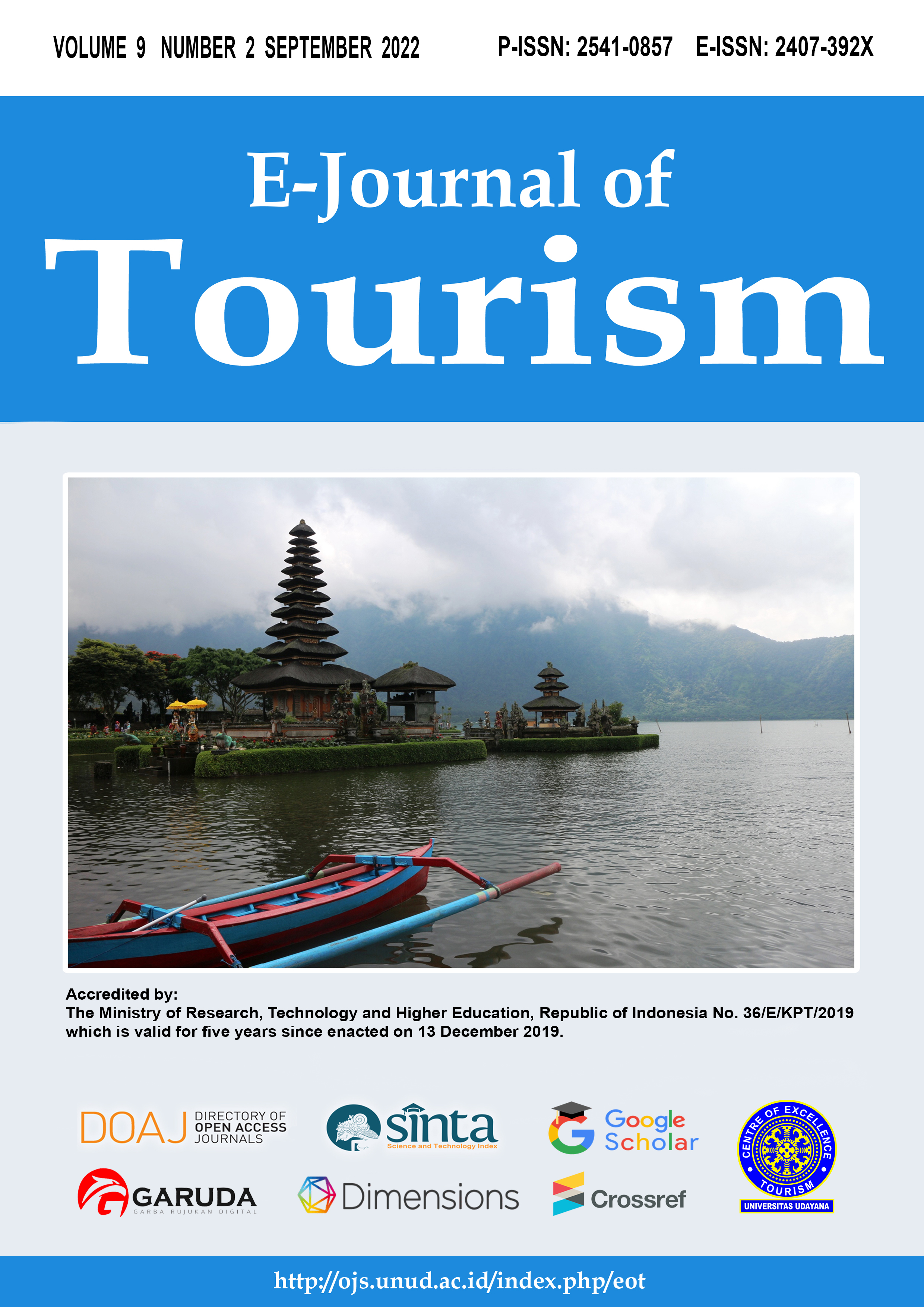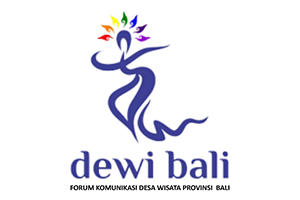Systematic Literature Review and Future Agenda: Leadership Style and Dimension in Rural Tourism Settings
Abstract
This article aims to outline research developments regarding leadership styles in rural tourism and a leadership measurement index to explore future research direction opportunities. A systematic literature review was conducted by reviewing a total final sample of 15 articles published from 2012-2021; the database sources used in the study were Elsevier, Emerald, MDPI, Taylor and Francais, and Harzing's Publish or Perish with the Scopus API Key based on inclusion and exclusion criteria for analysis and synthesis to meet the purpose of the article. Leadership styles in rural tourism are currently found in 14 leadership styles. All leadership styles in rural tourism illustrate the need for integration and networks to develop successful rural tourism, in contrast to the leadership styles adopted by other sectors. The dimension of leadership measurement in rural tourism is based on the rural tourism characteristics. There are twelve leadership dimensions measurement in rural tourism that are different from the measurement of leadership in general. There are theoretical and empirical gaps, so one of the challenges in applying the dimensions of leadership measurement is bridging research with applications in other sectors. This literature review is presented to describe the leadership style in rural tourism that is needed and has been widely adopted to help and support the community to find a successful leadership style in developing rural tourism.
Downloads
References
Bass, B.M. (1999), “Two decades of research and development in transformational leadership”, European Journal of Work and Organizational …, Taylor & Francis, available at:https://doi.org/10.1080/135943299398410.
Bass, B.M. and Avolio, B.J. (1993), “Spaef Transformational Leadership and Organizational Culture Transformational Leadership and Organizational Culture”, Source: Public Administration Quarterly, Vol. 17 No. 1, pp. 112–121.
Bass, B.M. and Yammarino, F.J. (1991), “Congruence of Self and Others’ Leadership Ratings of Naval Officers for Understanding Successful Performance”, Applied Psychology, Vol. 40 No. 4, pp. 437–454.
Bouchon, F. and Prideaux, B. (2019), “Leadership and Tourism Development in Rural South-East Asia: Analysis of a Capacity-building Project in a Rural Community in Timor-Leste”, Vol. 15, pp. 1–21.
Dwyer, L., Edwards, D., Mistilis, N., Roman, C. and Scott, N. (2009), “Destination and enterprise management for a tourism future”, Tourism Management, Elsevier Ltd, Vol. 30 No. 1, pp. 63–74.
Fisher, K. and Robbins, C.R. (2015), “Embodied leadership: Moving from leader competencies to leaderful practices”, Leadership, Vol. 11 No. 3, pp. 281–299.
Hampson, F.O., Held, D., McGrew, A., Goldblatt, D. and Perraton, J. (1999), “Global Transformations: Politics, Economics, and Culture”, International Journal, Vol. 54 No. 4, p. 705.
Haven-Tang, C. (2012), “Local leadership for rural tourism development: A case study of Adventa, Monmouthshire, UK”, Tourism Management Perspectives, Vol. 4, pp. 28–35.
Haven-Tang, C. and Jones, E. (2012), “Local leadership for rural tourism development: A case study of Adventa, Monmouthshire, UK”, Tourism Management Perspectives, Tourism Management Perspectives, USA, Vol. 4, pp. 28–35.
Kaiser, R.B., McGinnis, J.L. and Overfield, D. V. (2012), “The how and the what of leadership”, Consulting Psychology Journal, Vol. 64 No. 2, pp. 119–135.
Kennedy, V. and Augustyn, M.M. (2014), “Stakeholder power and engagement in an English seaside context: Implications for destination leadership”, Tourism Review, Vol. 69 No. 3, pp. 187–201.
Kirk, P. and Shutte, A.M. (2004), “Community leadership development”, Community Development Journal, academic.oup.com, available at: https://academic.oup.com/cdj/article-abstract/39/3/234/334435.
Kirkpatick, S.A. and Locke, E.A. (1991), “Leadership: do traits matter?”, Academy of Management Perspectives, Vol. 5 No. 2, pp. 48–60.
Kontogeorgopoulos, N., Churyen, A. and Duangsaeng, V. (2014), “Success Factors in Community-Based Tourism in Thailand: The Role of Luck, External Support, and Local Leadership”, Tourism Planning and Development, Vol. 11 No. 1, pp. 106–124.
Liburd, J.J. and Edwards, D. (2010), “Understanding the Sustainable Edited by ( G )”.
Liu, C., Dou, X., Li, J. and Cai, L.A. (2020), “Analyzing government role in rural tourism development: An empirical investigation from China”, Journal of Rural Studies, Elsevier Ltd, Vol. 79 No. October 2019, pp. 177–188.
Liu, Y. and Yang, W. (2019), “Leadership and governance tools for village sustainable development in China”, Sustainability (Switzerland), Vol. 11 No. 20, pp. 1–17.
Long, P.T. and Nuckolls, J.S. (1994), “Organising resources for rural tourism development:The importance of leadership, planning and technical assistance”, Tourism Recreation Research, Vol. 19 No. 2, pp. 19–34.
Marques, J. (2015), “The changed leadership landscape: What matters today”, Journal of Management Development, emerald.com, available at:https://doi.org/10.1108/JMD-02-2015-0010.
McGehee, N.G. (2015), “The central role of leadership in rural tourism development: a theoretical framework and case studies”, Journal of Sustainable Tourism, Vol. 23 No. 8, pp. 1277–1297.
Mitchell & Hall. (2005), “Rural tourism as sustainable business: Key themes and issues”, Rural Tourism as Sustainable Business.
Moscardo, G. (2005), “Peripheral tourism development: Challenges, issues and success factors”, Tourism Recreation Research, Vol. 30 No. 1, pp. 27–43.
Moscardo, G. (2008), “Sustainable Tourism Innovation: Challenging Basic Assumptions”, Tourism and Hospitality Research, Vol. 8 No. 1, pp. 4–13.
Moscardo, G. (2014), “Tourism and Community Leadership in Rural Regions: Linking Mobility, Entrepreneurship, Tourism Development and Community Well-Being”, Tourism Planning and Development, Vol. 11 No. 3, pp. 354–370.
Naderi, A., Nasrolahi Vosta, L., Ebrahimi, A. and Jalilvand, M.R. (2019), “The contributions of social entrepreneurship and transformational leadership to performance: Insights from rural tourism in Iran”, International Journal of Sociology and Social Policy, Vol. 39 No. 9–10, pp. 719–737.
Nomm, A.H.L., Albrecht, J.N. and Lovelock, B. (2020), “Advocacy and community leadership as functions in national and regional level destination management”, Tourism Management Perspectives, Elsevier, Vol. 35 No. November 2019, p. 100682.
Nordin, S. (2005), “Tourism of tomorrow”, Ostersund, Sweden: European Tourism Research …, available at: http://nordic-ictfore.vtt.fi/materiaali/ruotsi/nordin_tourism_of_tomorrow.pdf.
Nylander, M. and Hall, D. (2005), Chapter 2. Rural Tourism Policy: European Perspectives, Rural Tourism and Sustainable Business, Multilingual Matters, available at:https://doi.org/10.21832/9781845410131-005.
Pearce, C.L. and Conger, J.A. (2002), Shared Leadership: Reframing the Hows and Whys of Leadership, books.google.com, available at: https://books.google.com/books?hl=en&lr=&id=kvByAwAAQBAJ&oi=fnd&pg=PP1&dq=leadership&ots=Ug1Rr54gho&sig=Y59j53ag-c0Xc9RQO2kDmXXAY-s.
Pittaway, R.T.R.H.A.M. luke. (2005), “Thorpe et al. - 2005 - Using knowledge within small and medium-sized firms A systematic review of the evidence(2).pdf”, Vol. 7 No. 4, pp. 257–281.
Pröbstl-Haider, U., Melzer, V. and Jiricka, A. (2014), “Rural tourism opportunities: Strategies and requirements for destination leadership in peripheral areas”, Tourism Review, Vol. 69 No. 3, pp. 216–228.
Rondinelli, A Dennis and Heffron, M.J. (2009), “Leadership for Development: What Globalization Demands of Leaders Fighting ... - Google Books”, United States of America by Kumarian Press.
Russell, R.F. and Stone, A.G. (2002), “A review of servant leadership attributes: Developing a practical model”, Leadership & Organization Development …, emerald.com, available at:https://doi.org/10.1108/01437730210424.
Selin, S. (2017), “Elaborating the role of backbone leadership organizations in sustainable tourism development: The Monongahela River Valley Coalition”, Sustainability (Switzerland), Vol. 9 No. 8, p. 1367.
Slocum, S.L. and Everett, S. (2014), “Industry, government, and community: Power and leadership in a resource constrained DMO”, Tourism Review, Vol. 69 No. 1, pp. 47–58.
Tirado Ballesteros, J.G. and Hernández, M.H. (2019), “Promoting tourism through the EU LEADER programme: understanding Local Action Group governance”, European Planning Studies, Taylor & Francis, Vol. 27 No. 2, pp. 396–414.
Tom Boydell, Mike Pedler, J.B. (2010), “A Manager’S Guide To Leadership - Pedler, Mike, Burgoyne, John, Boydell, Tom - Google Books”, McGraw-Hill Publishing Company.
Tranfield, D., Denyer, D. and Smart, P. (2003), “Towards a Methodology for Developing Evidence-Informed Management Knowledge by Means of Systematic Review* Introduction: the need for an evidence- informed approach”, British Journal of Management, Vol. 14, pp. 207–222.
Wilson, S. (2001), “Factors for success in rural tourism development”, Journal of Travel Research, Vol. 40 No. 2, pp. 132–138.
Xu, K., Zhang, J. and Tian, F. (2017), “Community leadership in rural tourism development: A tale of two ancient Chinese villages”, Sustainability (Switzerland), Vol. 9 No. 12, available at:https://doi.org/10.3390/su9122344.
Yukl, L.G. (1999), “AN EVALUATION OF CONCEPTUAL WEAKNESSES IN TRANSFORMATIONAL AND CHARISMATIC LEADERSHIP THEORIES”, The Leadership Quarterly, Vol. 10 No. 2, pp. 285–305.
Zmys̀lony, P. (2014), “Identification of leadership in emerging tourist destinations”, Tourism Review, Vol. 69 No. 3, pp. 173–186.

This work is licensed under a Creative Commons Attribution 4.0 International License.
The copyright of the received article shall be assigned to the journal as the publisher of the journal. The intended copyright includes the right to publish the article in various forms (including reprints). The journal maintains the publishing rights to the published articles.




















